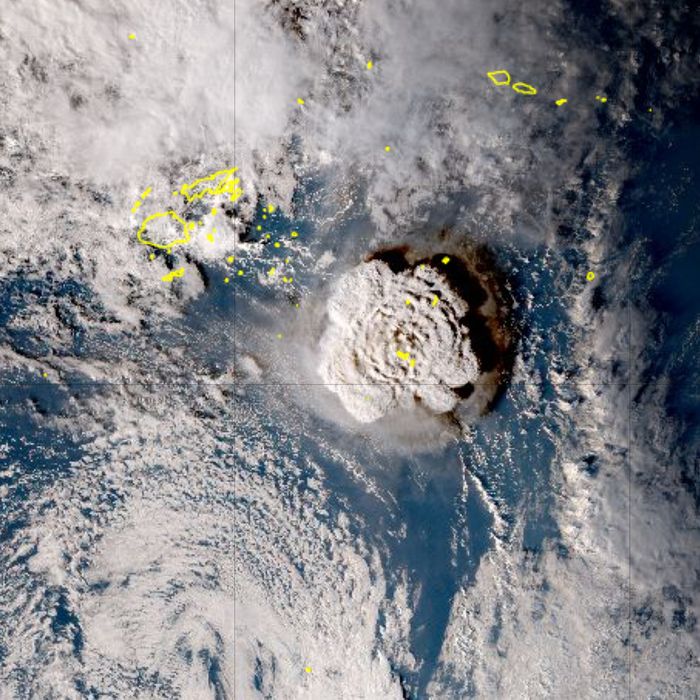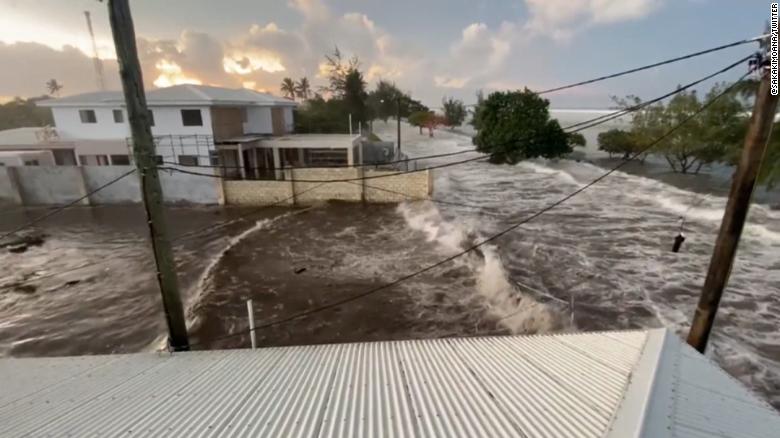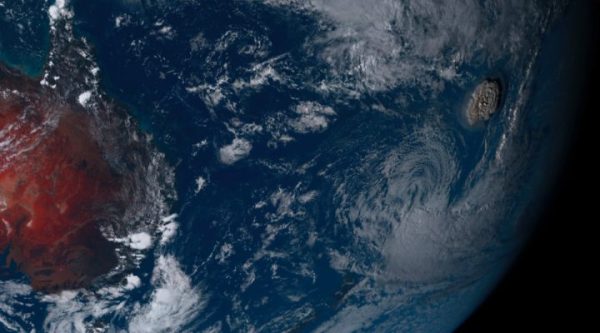Hunga Tonga Undersea Volcano : Violent Eruption
"We have a nightmare situation of an isolated community experiencing the effects of a large volcanic ash plume producing significant volcanic lightning, as well as a tsunami.""Seeing that ash plume, that volcanic lightning, and that tsunami leave me feeling sick thinking about the people being impacted by this large eruption."Janine Krippner, volcanologist, Smithsonian Global Volcano Program
 |
| Satellite image of eruption of the Hunga Tonga Hunga Ha’apai volcano on Saturday. Photo: Himawari-8/Japan Meterological Agency |
How large, how powerful? The ash and smoke plume from Hunga Tonga volcano covered a vast area, the plume thick enough to blot out the sun, though this was a night-time eruption. Within the plume static discharges towered twice the height of Earth's most fiercely volatile thunderstorms, the result of which was barrages of volcanic lightning striking out of pyrocumulonimbus clouds produced by volcanoes.
It is not yet known how much danger Tongans faced, how many people may have died if any or been injured, much less the damage to infrastructure.
Sensitive lightning detection networks and satellites following the volcano's initial blast counted the equivalent of 70 lightning strikes per second. A tsunami of several metres was generated by the powerful blast, leading to warning of tsunami advisories for Tongans to immediately seek higher ground. Advisories were also promulgated across Hawaii, Alaska, British Columbia and the west coast of North America; Washington, Oregon and California included.
 |
| Ash rises into the air after a powerful underwater volcanic eruption in the South Pacific. |
"Gravity waves" captured by satellite imagery were seen rippling outward from the area that the plume punctured in the layer of the lower atmosphere. The result was dense perturbations sent outward similar to waves surrounding a stone tossed into a lake.The volcano, located about 65 kilometres north of the main island of Tongatapu in the southwest Pacific explosively erupted Saturday evening sending ash 100,000 feet in height, generating an atmospheric shock wave rippling across the globe.
The eruption was heard in Alaska, 8,000 kilometres distant from Tonga. Home to 135,000 people, Tonga is northeast of New Zealand, southeast of Fiji. There is speculation that the volcano could be responsible for affecting the Earth's climate. Atmospheric scientists are collecting data to determine what role the volcano's eruption can produce atmospherically across the world.
Hunga Tonga is an active underwter volcano which erupts from time to time; as it did in 2009, in 2014 and in December of 2021. Since the December eruption it has sporadically exhibited spurts of activity Until January 15 when an especially explosive eruption occurred to produce the most remarkably striking display of volcanic power that weathere satellites captured.
 |
| A tsunami has hit Tonga's largest island, Tongatapu. |
The plume the eruption produced was spectacularly towering, reaching a height of 30,500 metres, approximately three times the altitude a commercial aircraft achieves in flight. Tonga's plume was buoyant enough to earn it the capacity to penetrate the lowest level of Earth's atmosphere and from there continue to pierce the stratosphere until pockets of air and ash subsided.
Experts at the National Weather Service in Anchorage and University of Alaska Fairbanks confirmed reports of audible booms early Saturday in Alaska that originated from the volcano. A phenomenon that affirms the sound travelled at close to 1,300 km/h. Much of the sound produced fell within the spectrum of what can be detected by humans.
"It’s not yet clear how powerful the eruption was or what long-term impact it could have. Volcanologists have developed a scale that describes the size of explosive volcanic eruptions based on magnitude and intensity — the volcanic explosivity index, or VEI. Prior eruptions from the undersea volcano near the nation of Tonga were 2. (For context, Krakatoa’s 1883 eruption, which was one of the most deadly volcanic eruptions of modern history, had a VEI of 6.)""But while some experts predict Saturday morning’s eruption could be, at least, a VEI of 4, it’s too soon to tell. “Until we know how much material has been ejected (made harder by the underwater component), we can’t use the scale,” volcanologist Jess Phoenix tweeted. “This means that while we know this eruption is consequential, we won’t have all the info on it for a while.” Since the eruption is still ongoing, there could be more explosions, collapses, and tsunamis to come — or this could be it for a while."Intelligencer
 |
| Our research into these earlier eruptions suggests this is one of the massive explosions the volcano is capable of producing roughly every thousand years. (NICT via AP) |
Labels: Ash Plume, Hunga Tonga Volcano, Thunder/Lightning, Tonga, Tsunami, Undersea Volcanic Eruption

0 Comments:
Post a Comment
<< Home